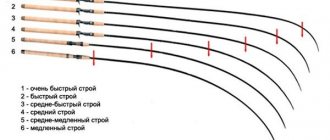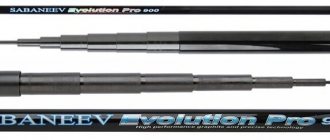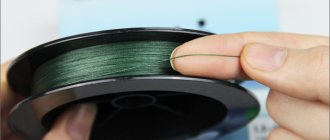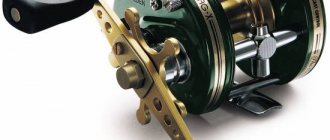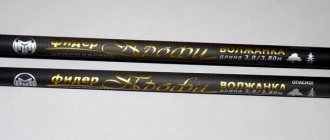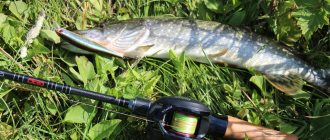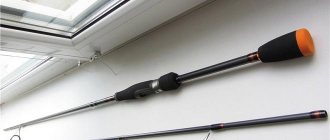What is a power spinning reel?
Power spinning reels are not available in every fishing store. Such equipment is necessary for fishing on the open sea. Often fishermen find excellent use for them when they try to catch catfish, taimen, and chinook salmon.
Power equipment will be required in the following types of fishing - tropical jigging and popping. Externally, power coils resemble a standard inertia-free model, only they differ in larger dimensions and scaffolding capacity. However, the peculiarity of the power model is its power, which allows you to catch large prey, be it tuna, GT, grouper, and other species.
Operating principle and design of spinning reels
It is impossible to choose the right thing without knowing exactly why you need it and what functions it should perform. Therefore, first, let’s figure out what a spinning reel is used for and how it works.
A spinning reel ensures easy and quick casting of bait to the desired distance and smooth line movement. It also allows you to keep even large fish on the hook, since you can control the speed of reeling in the fishing line.
Main operating components of the device:
- The spool on which the fishing line is wound.
- Line layer that controls correct winding.
- Video clip.
- Brake with switch that fixes the fishing line.
- Transmission mechanism.
- Handle for catching fish.
This is a simplified description of the reel, for a general idea of what functions it performs, for those who have not dealt with spinning rods at all before. Well, experienced fishermen don’t need to explain anything, they already know perfectly well how the reel works.
Design and technical characteristics
Each inertia-free power coil has a unique structure. However, like standard equipment of this type, the reel has a single base. Therefore, if you do not delve into the intricacies of each option, the device can be represented by the following parts.
1. Body with fastening tab. This is the base of the mechanism, which is often a cast form made of polymer or metal.
2. Rotor with folding arm. The main device rotates this element.
3. Scaffolding handle. This part is equipped with a roller, which is necessary for collecting the fishing line without any defects.
4. Spool. This is where the fishing line or braided cord is located. Often this drum is made from light metal alloys or polymers.
5. The handle is used to create rotational movement for the entire mechanism.
The points described above are a simple definition of the design of the power model. In addition to these components, each equipment is equipped with additional elements that expand functionality and make fishing easier.
Also, every fisherman needs to understand the key parameters of a power reel in order to make the right choice. Most information can be found out from the markings that are marked on the body, drum, or indicated in the passport.
There are 4 main parameters
.
1. Gear ratio. This characteristic has the form of numbers, which are presented as 5.3:1 or 4.7:1. The high-speed model has a ratio of 5.5:1 and higher. Such installations can be used for fishing with float tackle. Power options with a ratio of 4.2:1 and the like are necessary for spinning fishing.
2. Bearings. This is extremely important, because the stability and ease of activity of the mechanism depends on the quantity of these elements. However, this increases the weight and price. There are budget options that are equipped with three or less bearings. At the same time, power equipment from a popular manufacturer may have a device with 12 or more ball bearings. This means that you should always look for a compromise when choosing equipment.
3. Friction brake. Another extremely important component in the design. With its help, the load on the line and on the form is reduced when fishing for large prey. There are two types of clutch - front and rear. If you need lighter equipment, then choose the first option, heavy equipment – the second. It is also important to remember that the reel can be calibrated using this brake.
4. Spool dimensions. In addition to the dimensions, which are already known, it is important to know the material used in creation. Plastic is most often used. Such models have a low price. There are also representatives from graphite and metal alloys. The best models come with spools made of various alloys.
Moreover, it is worth noting that the power reels are equipped with comfortable handles. Most spinning rigs allow you to change the position of the handle so that the fisherman can adjust the reel to his needs.
How to choose a spinning reel
Many people are looking for ways to choose a reel for their fishing rod. Usually the best solution is an inertia-free device, but its parameters must be taken into account. After all, it is not the reel itself that is chosen, but the option that will be ideally combined with the fishing rod. This means that you first need to purchase the spinning rod itself, and then select a reel for it.
You may be interested in: Aluminum boats
This option is considered correct for the reason that when choosing a reel, they are also guided by the characteristics of the fishing rod. This allows you to make your gear more balanced. They will be very comfortable for the type of fishing you prefer and will not cause fatigue. So, fishing rods and reels are combined as follows:
- If a spinning rod has a test weight of up to 12 g, a reel up to 2000 is perfect for it. This is gear that is used for catching chub, perch and other small predators using light and ultralight baits.
- A rod with a test weight of 10-30 g is combined with a reel of 2000-3500. It is ideal for twitching, jig fishing, fishing with a retractable leash and other similar options. This fishing rod is also used for fishing with wobblers, spoons, and spinners. This is usually the most popular rod and reel combination.
- If you use jerks, jigs, heavy jigs and other large baits, you need to install a reel of 4-5 thousand. With its help you can even catch trophy fish. It is durable and reliable.
The ideal solution is to choose a reel at the same time as a spinning rod. This will allow you to set the balance of the tackle right in the store, check it and find out whether the reel is suitable for this fishing rod.
Top 5 power spinning reels
Power coils have a wide range of models. However, there are top 5 best representatives of this class.
1. Daiwa Black Widow 5500A. Inertia-free model, designed for the left hand. Has a front drag and an aluminum spool. The gear ratio is 4.1:1 and the size is 5500.
2. Ryobi Ecusima 2000Vi. Another variety with a front clutch and a handle for the left hand. The case material is graphite, as well as 4 ball bearings.
3. Feeder Concept Pilot 7 4000FD. Reel with aluminum spool and six ball bearings. There is a front friction brake and a handle for the left hand. The kit also includes a spare spool.
4. Siweida Impulse 400. Has a pair of friction brakes - front and rear, baitrunner. The body is made of graphite and the spool is made of aluminum. In addition, the kit includes an additional spool. Gear ratio 5.2:1.
5. Shimano Catana 3000 FD. One of the popular models of the inertia-free type. There is a front clutch and a pair of ball bearings. The spool is made of aluminum.
Coil size
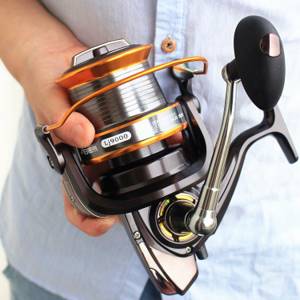
Before choosing a reel, you need to decide on its size. The power of the product and its other indicators depend on this. Special units of measurement in thousands are used to indicate size. The most successful classification is considered to be from Shimano and Daiwa.
You may be interested in: Norstream Dynamic spinning rod
Reels 1000-2500 are designed for light spinning, working with small baits and catching small fish. If you are looking for which reel to choose for spinning with medium or heavy baits, it is worth considering options in sizes 3000-5000. Large sizes are usually not suitable for spinning rods and are used in sea fishing and carp fishing.
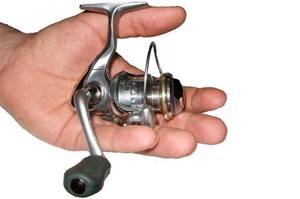
Reel classification
One of the main aspects in the question of how to choose a spinning reel is determining the required type of device. There are three types of reel gear:
- inertialess;
- inertial;
- cartoon.
Inertia-free - the most popular and versatile type. Fishermen call them “meat grinders” .
They are diverse, so among them you can always choose a reel for your spinning rod, regardless of your favorite style of fishing.
Inertial coils are the old type models. Therefore, in this article we will not consider how to choose a reel of this type.
With the advent of their inertia-free counterparts, they lost their relevance due to a significant drawback: after casting the bait, the drum continues to rotate by inertia, forming a long “beard” of fishing line.
Multiplier models are suitable for trolling and jig fishing. This is a good choice for fishing for pike perch at night. Only with a multiplier can an angler feel the lightest touches of a predator on the bait, even when casting over long distances.
Expert opinion
Knipovich Nikolai Mikhailovich
Zoologist, hydrobiologist. I am interested in fishing at a professional level.
Attention! Good advice on how to choose a spinning reel for a beginner: take a closer look at the inertia-free “meat grinders”. This is a good start for a novice spinning angler who has not yet decided on his favorite fishing style.
Now we’ll find out how to choose the right reel for a spinning rod, taking into account the parameters. To do this, let's look at the important characteristics of the device and find out what they affect.
Gear ratio (reduction)
“Transmission” or reduction is an important parameter of the coil, characterizing its power properties. This is the number of rotations of the rotor per revolution of the handle. The average reduction values of most coils are 5.0 – 5.5, the extreme limits are 4.0 – 6.5.
Obviously, turning the handle of a reel with a gear ratio of 6 under load is harder than 4, but the rotor will rotate at a higher speed. And vice versa: more traction - less speed. Therefore, models with a reduction of 4.0 - 5.0 are considered power, 5.0 - 5.5 - medium, 5.5 - 6.5 - high-speed.
Accordingly, the technique of power fishing with a high-speed reel will differ in that you will have to use a spinning rod more, “pumping out” the fish. With power transmission, it’s the other way around - you can simply raise the spinning rod and catch the fish with just the reel.
The highest-speed models are good both when fast retrieving is necessary and for typical “spot” fishing. In the first case, a typical example is fishing for asp in the Devonian, in the second - hunting for small things (perch, rudd, pike) “from the grass”, when a bite is likely only in the first two to three meters of the retrieve, and then the bait is quickly exhausted. Therefore, these reel models really provide high line reeling speed.
For other spinning models, this figure is approximately the same and is due to the range of retrieve speeds for the main baits. After all, reels with low gearing have a wider spool, while reels with high gearing have a narrower one. Therefore, if the number of revolutions is less, then more fishing line is wound in one revolution. This means that the winding speed changes little.
It is clear that if you are constantly hunting for “big fish”, a power reel is more suitable for you - for most other spinning players, the average “gear” will be optimal.
Reel gear parameters
A spinning reel is selected according to the following parameters:
- material and mass;
- timber capacity and size;
- method of laying fishing line;
- gear ratio;
- smooth ride.
Sometimes it is important to choose a spinning reel with a friction brake. Let's take a brief overview of all the parameters.
Material and weight
When asking how to choose a spinning reel, it is important to take into account the material of the gear. It can be metal or plastic . Plastic models are lightweight: they do not weigh down the rod and are ideal for ultralight fishing. With the same dimensions, their metal counterparts are heavier. So don't buy them to mount on a light rod.
For long-distance fishing, give preference to a metal reel. The line glides along it better, and therefore it is much easier to cast the bait into the distance. Metal is also more durable compared to plastic. And strength is the main condition for maintaining the integrity of the drum. After all, even a small notch can reduce casting distance by 30%.
If choosing a budget spinning reel is your priority, buy a “meat grinder” or a plastic multiplier.
Forest capacity and size
How do you know what size reel to choose for a spinning rod? This depends on the length and thickness of the line used. The thicker the line, the larger the reel should be, and vice versa. There is no point in taking a large model if you will be laying a thin thread on the drum: there is no point in making the tackle heavier.
Expert opinion
Knipovich Nikolai Mikhailovich
Zoologist, hydrobiologist. I am interested in fishing at a professional level.
Important! The capacity of the coils is indicated in thousands. For example, the number 1000 indicates that this model will accommodate 100 meters of fishing line with a thickness of 0.1 mm or 50 meters with a diameter of 0.2 mm. Number 3000: 100 meters at 0.3 mm, 200 at 0.15 or 300 at 0.1.
How to choose the right spinning reel taking into account the size of the gear? For light rods and fishing for small fish, choose models with a size in the range of 1000-2500. When catching large fish, you will need a drum capacity of 3000 to 5000. But this is not the limit. However, sizes larger than 5000 are chosen only for fishing at sea or for hunting fish of record weight.
Method of laying and feeding fishing line
In “meat grinders” there are two ways of laying scaffolding:
- worm feed (models with endless screw);
- crank feed (analogues with a rocker).
Both methods, with high-quality execution of the mechanism, ensure smooth winding of the fishing line onto the spool: dips and humps are not detected.

It is better to select a spinning reel taking into account the method of winding the line onto the drum. It can be straight or cross . With straight winding, the turns are stacked on top of each other. This allows you to increase the capacity of the spool with small sizes, but with this method loops can be dropped and “beards” can form.
Cross winding does not have such disadvantages. However, with equal dimensions in terms of capacity, cross coils will be inferior to straight coils.
Gear ratio
This is a very important point in the question of how to choose a spinning reel. This parameter tells you how many revolutions the line handler makes with one revolution of the reel handle. For example, the entry “1:5” says that for 1 revolution of the handle the line handler will make 5 revolutions.
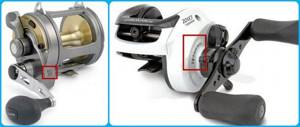
“Meat grinders” and gear ratio multipliers are:
- high-speed (1:6 - 1:7.2);
- universal (1:4.7 - 1:1.6);
- power (1:4 - 1:4.7).
Power models are suitable for fishing large predators, and high-speed models are suitable for ultralight fishing. In other cases, the choice of spinning reel should be on universal models.
Smooth ride
This characteristic is largely determined by the number of bearings in the gear. They provide:
- easy move;
- elimination of backlashes;
- long service life of elements subject to friction.
It turns out that you need to choose a spinning reel with the maximum number of bearings? No, what is much more important is not the number of bearings, but the manufacturer’s ability to place them in the right places. Good smooth running will be in those models in which bearings are located in the line roller and on the reel axis. It's enough.
